The AMD Radeon R9 Fury X Review: Aiming For the Top
by Ryan Smith on July 2, 2015 11:15 AM ESTCompute
Shifting gears, we have our look at compute performance. As an FP64 card, the R9 Fury X only offers the bare minimum FP64 performance for a GCN product, so we won’t see anything great here. On the other hand with a theoretical FP32 performance of 8.6 TFLOPs, AMD could really clean house on our more regular FP32 workloads.
Starting us off for our look at compute is LuxMark3.0, the latest version of the official benchmark of LuxRender 2.0. LuxRender’s GPU-accelerated rendering mode is an OpenCL based ray tracer that forms a part of the larger LuxRender suite. Ray tracing has become a stronghold for GPUs in recent years as ray tracing maps well to GPU pipelines, allowing artists to render scenes much more quickly than with CPUs alone.
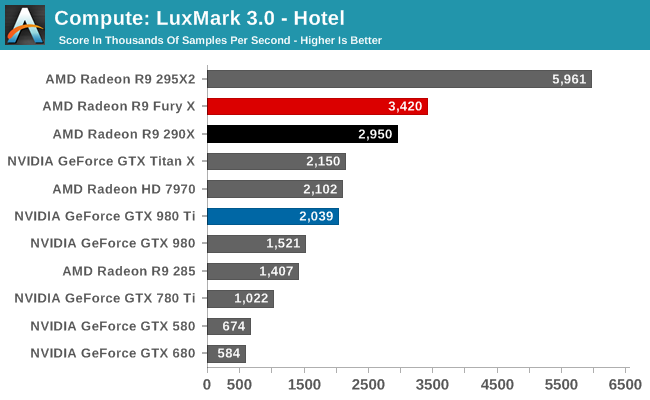
The results with LuxMark ended up being quite a bit of a surprise, and not for a good reason. Compute workloads are shader workloads, and these are workloads that should best illustrate the performance improvements of R9 Fury X over R9 290X. And yet while the R9 Fury X is the fastest single GPU AMD card, it’s only some 16% faster, a far cry from the 50%+ that it should be able to attain.
Right now I have no reason to doubt that the R9 Fury X is capable of utilizing all of its shaders. It just can’t do so very well with LuxMark. Given the fact that the R9 Fury X is first and foremost a gaming card, and OpenCL 1.x traction continues to be low, I am wondering whether we’re seeing a lack of OpenCL driver optimizations for Fiji.
For our second set of compute benchmarks we have CompuBench 1.5, the successor to CLBenchmark. CompuBench offers a wide array of different practical compute workloads, and we’ve decided to focus on face detection, optical flow modeling, and particle simulations.
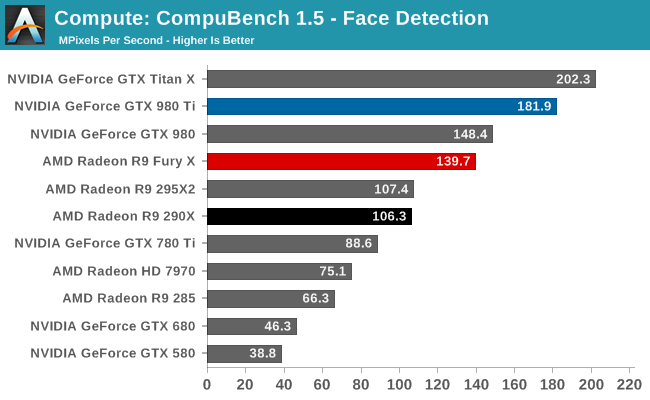
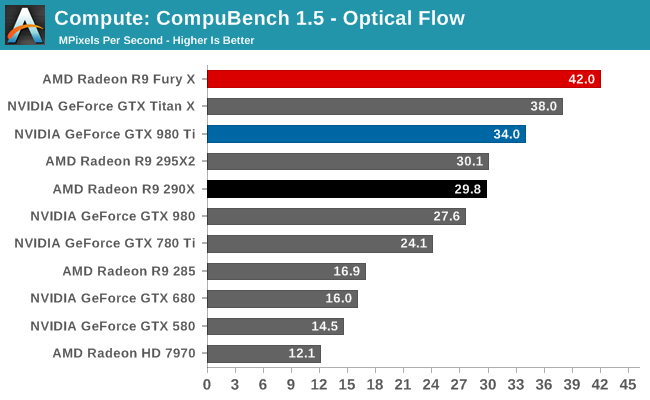

Quickly taking some of the air out of our driver theory, the R9 Fury X’s performance on CompuBench is quite a bit better, and much closer to what we’d expect given the hardware of the R9 Fury X. The Fury X only wins overall at Optical Flow, a somewhat memory-bandwidth heavy test that to no surprise favors AMD’s HBM additions, but otherwise the performance gains across all of these tests are 40-50%. Overall then the outcome over who wins is heavily test dependent, though this is nothing new.
Our 3rd compute benchmark is Sony Vegas Pro 13, an OpenGL and OpenCL video editing and authoring package. Vegas can use GPUs in a few different ways, the primary uses being to accelerate the video effects and compositing process itself, and in the video encoding step. With video encoding being increasingly offloaded to dedicated DSPs these days we’re focusing on the editing and compositing process, rendering to a low CPU overhead format (XDCAM EX). This specific test comes from Sony, and measures how long it takes to render a video.
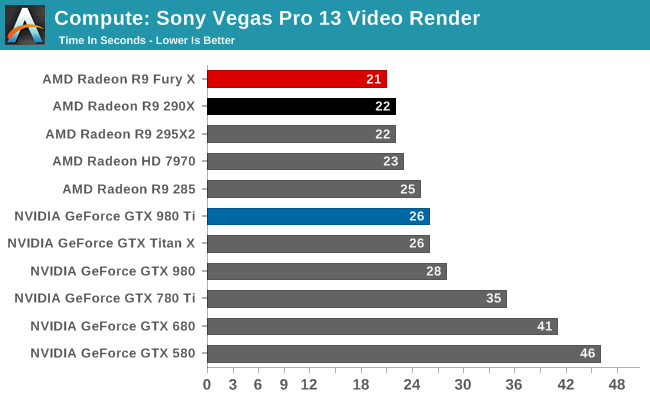
At this point Vegas is becoming increasingly CPU-bound and will be due for replacement. The Fury X none the less shaves off an additional second of rendering time, bringing it down to 21 seconds.
Moving on, our 4th compute benchmark is FAHBench, the official Folding @ Home benchmark. Folding @ Home is the popular Stanford-backed research and distributed computing initiative that has work distributed to millions of volunteer computers over the internet, each of which is responsible for a tiny slice of a protein folding simulation. FAHBench can test both single precision and double precision floating point performance, with single precision being the most useful metric for most consumer cards due to their low double precision performance. Each precision has two modes, explicit and implicit, the difference being whether water atoms are included in the simulation, which adds quite a bit of work and overhead. This is another OpenCL test, utilizing the OpenCL path for FAHCore 17.
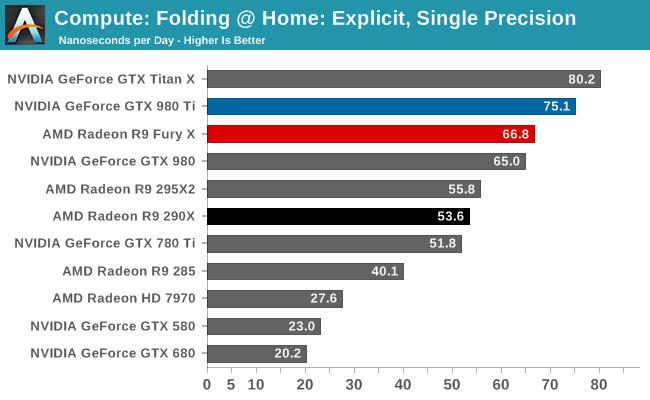

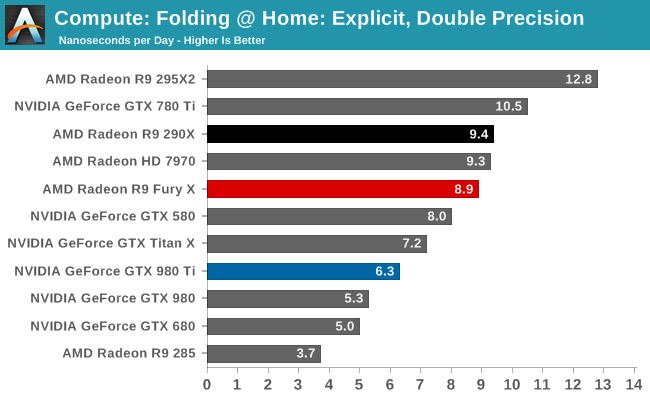
Both of the FP32 tests for FAHBench show smaller than expected performance gains given the fact that the R9 Fury X has such a significant increase in compute resources and memory bandwidth. 25% and 34% respectively are still decent gains, but they’re smaller gains than anything we saw on CompuBench. This does lend a bit more support to our theory about driver optimizations, though FAHBench has not always scaled well with compute resources to begin with.
Meanwhile FP64 performance dives as expected. With a 1/16 rate it’s not nearly as bad as the GTX 900 series, but even the Radeon HD 7970 is beating the R9 Fury X here.
Wrapping things up, our final compute benchmark is an in-house project developed by our very own Dr. Ian Cutress. SystemCompute is our first C++ AMP benchmark, utilizing Microsoft’s simple C++ extensions to allow the easy use of GPU computing in C++ programs. SystemCompute in turn is a collection of benchmarks for several different fundamental compute algorithms, with the final score represented in points. DirectCompute is the compute backend for C++ AMP on Windows, so this forms our other DirectCompute test.
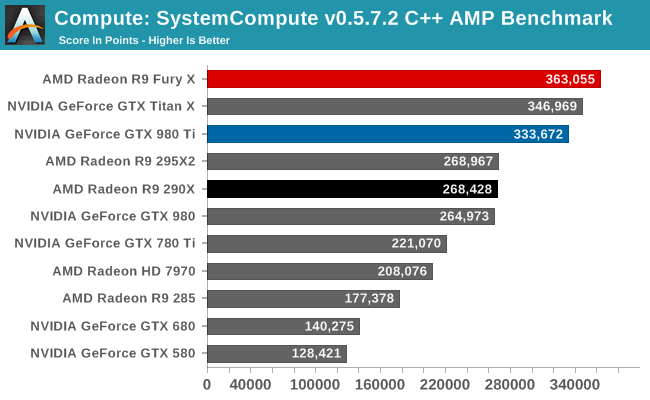
Our C++ AMP benchmark is another case of decent, though not amazing, GPU compute performance gains. The R9 Fury X picks up 35% over the R9 290X. And in fact this is enough to vault it over NVIDIA’s cards to retake the top spot here, though not by a great amount.










458 Comments
View All Comments
just4U - Saturday, July 4, 2015 - link
I thought it was great as well.. It had a lot more meat to it then I was expecting. Ryan might have been late to the party but he's getting more feedback than most other sites on his review so that shows that it was highly anticipated.B3an - Saturday, July 4, 2015 - link
I don't understand why the Fury X doesn't perform better... It's specs are considerably better than a 290X/390X and it's memory bandwidth is far higher than any other card out there... yet it still can't beat the 980 Ti and should also be faster than it already is compared to the 290X. It just doesn't make sense.just4U - Saturday, July 4, 2015 - link
Early drivers and perhaps the change over into a new form of memory tech has a bit of a tech curve that isn't fully realized yet.Oxford Guy - Saturday, July 4, 2015 - link
Perhaps DX11 is holding it back. As far as I understand it, Maxwell is more optimized for DX11 than AMD's cards are. AMD really should have sponsored a game engine or something so that there would have been a DX12 title available for benchmarkers with this card's launch.dominopourous - Saturday, July 4, 2015 - link
Great stuff. Can we get a benchmarks with these cards overclocked? I'm thinking the 980 Ti and the Titan X will scale much better with overclocking compared to Fury X.Mark_gb - Saturday, July 4, 2015 - link
Great review. With 1 exception.Once again, the 400 AMP number is tossed around as how much power the Fury X can handle. But think about that for one second. Even a EVGA SuperNOVA 1600 G2 Power Supply is extreme overkill for a system with a single Fury X in it, and its +12V rail only provides 133.3 amps.
That 400 AMP number is wrong. Very wrong. It should be 400 watts. Push 400 Amps into a Fury X and it most likely would literally explode. I would not want to be anywhere near that event.
AngelOfTheAbyss - Saturday, July 4, 2015 - link
The operating voltage of the Fury chip is probably around 1V, so 400A sounds correct (1V*400A = 400W).meacupla - Saturday, July 4, 2015 - link
okay, see, it's not 12V * 400A = 4800W. It's 1V (or around 1V) * 400A = 400W4800W would trip most 115VAC circuit breakers, as that would be 41A on 115VAC, before you even start accounting for conversion losses.
bugsy1339 - Saturday, July 4, 2015 - link
Anyone hear about Nvidia lowering thier graphics quality to get a higher frame rate in reviews vs Fury? Reference is semi accurate forum 7/3 (Nvidia reduces IQ to boost performance on 980TI? )sa365 - Sunday, July 5, 2015 - link
I too would like to know more re:bugsy1939 comment.Have Nvidia been caught out with lower IQ levels forced in the driver?